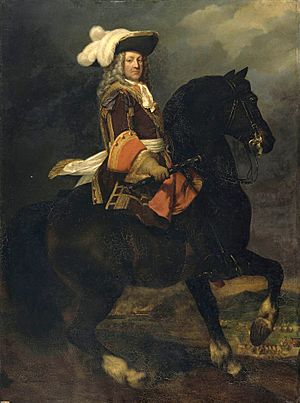Battle of Brihuega facts for kids
Quick facts for kids Battle of Brihuega |
|||||||
|---|---|---|---|---|---|---|---|
| Part of the War of the Spanish Succession | |||||||
 A portrait of the Duke of Vendôme |
|||||||
|
|||||||
| Belligerents | |||||||
| Commanders and leaders | |||||||
| Strength | |||||||
| 10,000 | 4,000 | ||||||
| Casualties and losses | |||||||
| 1,200 dead or wounded | 600 dead 3,400 wounded or captured |
||||||
The Battle of Brihuega was a big fight that happened on December 8, 1710. It was part of the War of the Spanish Succession, a long war in Europe. During this battle, a British army group, led by James Stanhope, 1st Earl Stanhope, was trying to get away from Madrid. They got stuck in the town of Brihuega. A combined French and Spanish army, led by Louis Joseph, Duke of Vendôme, attacked them. The British were defeated, and this battle helped end Britain's part in the war.
Why the Battle Happened
In 1710, the armies supporting Archduke Charles (who wanted to be King of Spain) won two battles. These wins allowed them to take over Madrid, the capital of Spain, for the second time. But their army was getting smaller because of fighting and sickness. They also faced attacks from Spanish guerrilleros, who were like small groups of fighters.
The French and Spanish army, supporting Philip V, was quickly rebuilt. A very skilled French general, the Duke of Vendôme, came to help Philip V. He brought French soldiers and the Irish brigade to join the Spanish troops.
Life in Madrid became very hard for the Archduke's army. Most people had left the city. So, on November 9, the Archduke's army decided to leave Madrid and go back to Barcelona. The Archduke himself rode ahead with a small group of soldiers. The rest of the army marched in two separate groups. One group, with 12,000 men, was led by General Guido Starhemberg. The other group, with 4,000 British soldiers, was led by James Stanhope, 1st Earl Stanhope. These two groups marched a day apart, which was a risky move.
The Fight at Brihuega
General Vendôme, leading the French and Spanish army, chased after the British soldiers. He moved his army incredibly fast, even though it was winter. Vendôme was so determined that he even swam across the flooded Henares river with his cavalry. In just a few days, he caught up with Stanhope's British group in Brihuega.
Stanhope was surprised by how fast Vendôme's army moved. He said that no one with him thought the enemy's foot soldiers were anywhere near. Stanhope barely had time to send a message to the main army, which was far away. Vendôme's army surrounded Brihuega on the evening of December 8.
The next morning, the French and Spanish forces began to attack the town. They used heavy cannon to blast holes in the walls. They even set off a mine under one of the gates. The British soldiers fought bravely, firing their weapons until they ran out of gunpowder. Then, they fought hand-to-hand with bayonets as Vendôme's soldiers stormed into the town. There was fierce fighting in the streets. The British even tried to set fire to buildings the attackers had taken, but it didn't stop them. General Stanhope realized that fighting more would only cause more deaths for no reason. So, he agreed to surrender, and his army became prisoners of war.
What Happened Next
Right after Vendôme signed the surrender papers, he found out that General Starhemberg was marching to help Stanhope. On December 10, Vendôme's army met Starhemberg's army in another big fight called the battle of Villaviciosa. After that battle, Starhemberg's army continued their retreat.
The British soldiers captured at Brihuega didn't stay prisoners for long. They were exchanged and sent home in October 1711.
This defeat helped the British government decide to make peace with France. They signed a peace agreement called the Treaty of Utrecht. Even though some people didn't like the idea of peace without Spain, the Allied forces left. The very last battle of the war was the Siege of Barcelona in 1714.
See also
 In Spanish: Batalla de Brihuega para niños
In Spanish: Batalla de Brihuega para niños

